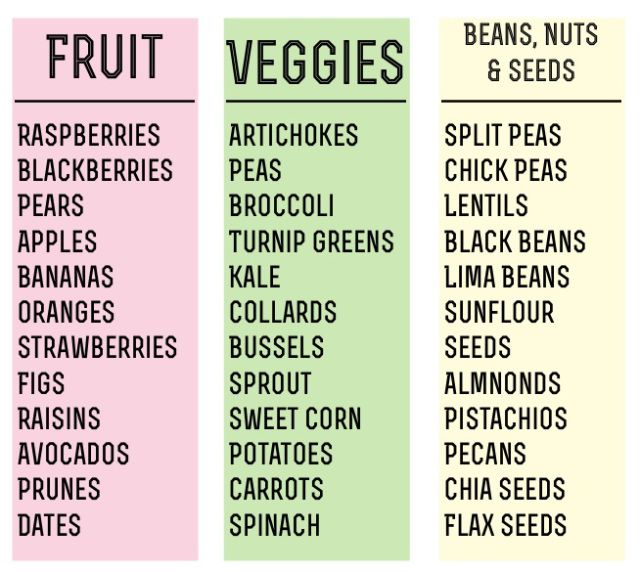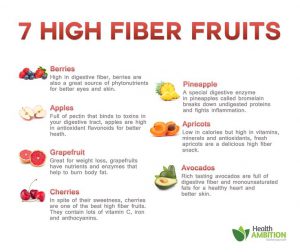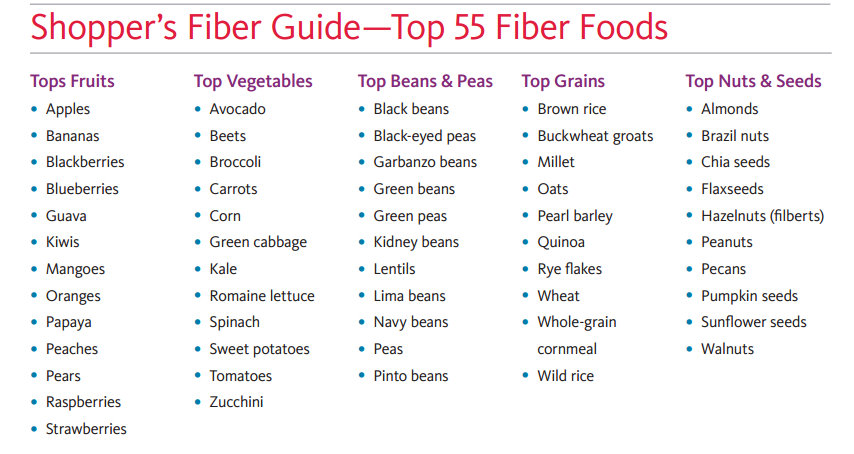High Fiber Foods Good For Your Health
Fiber in the diet is very important. This especially true for individuals that are on a gluten free diet because of gluten sensitivity or have celiac disease. These individuals may have difficulty in eating sufficient fiber in their diet every day. It’s important to consume foods that have high values of fiber in them. In fact, most Americans usually eat about 15 grams of fiber per day which is far below the minimum daily requirement. A healthy diet consists of vitamins, minerals, protein and fiber. This is true for those that are on a gluten free diet. So, focus on high fiber gluten free foods for proper nutrition.
When you go shopping be sure to include high fiber foods in planning the gluten free meals. This may take some time in reading the nutrition labels so you become familiar with the foods that contain high values of fiber in them.
How much fiber should I get per day? For women, between the ages of 21-50, they should consume 25 grams per grams of fiber per day, and above 50, 21 grams per day. Men should consume about 35 grams of fiber per day.
Some foods that contain high fiber are…
- Lettuce
- Dark leafy greens
- Broccoli
- Okra
- Cauliflower
- Sweet Potatoes
- Carrots
- Kale
- Cabbage
- Asparagus
Try to get the most fiber by consuming beans, fruits, nuts, seeds, vegetables and whole grains.
Check out the video below on fiber – Eat the Right Fiber
Table of Contents
To assist you in getting to the topic of interest, just click on the subject link and you will be taken directly to that section. Or, you can scroll down to view them all.
- Benefits of Fiber in the Diet
- Good Sources of Fiber
- Impact of Too Much Fiber
- Effects of Too Little Fiber
- Food Groups With Good Fiber
- Conclusion
- Best Selling High Fiber Foods By Category
Benefits of Fiber in the Diet
Fiber is basically composed of plant-based food matter (i.e., fruits, veggies, whole grains, and legumes) that can’t be broken down by your digestive system. Whole foods contain both soluble (dissolves in water) and insoluble (does not dissolve in water) fiber. Although the recommendations below don’t distinguish between these two types of fiber, they are different and have distinct functions — soluble fiber helps to reduce cholesterol and glucose levels, and insoluble fiber helps with constipation by increasing fecal bulk.
Additional benefits include:
- Keeping you regular – Fiber decreases the risk of constipation by bulking up and softening your stool.
- Maintaining your bowel health – Fiber may prevent the development of diverticulitis and hemorrhoids. It has also been shown to reduce the symptoms of irritable bowel syndrome (IBS) in some cases.
- Lowering cholesterol and blood glucose levels – By reducing bad (LDL) cholesterol and blood glucose levels, soluble fiber also leads to a decreased risk for cardiovascular disease, coronary heart disease, and type II diabetes.
- Controlling your appetite/weight – Foods that contain fiber are typically low in fat, energy-dense, take more time to chew, keep you full for longer, and block some of the digestion of fats and proteins.
Good Sources of Insoluble & Soluble Fiber
Some good sources of insoluble fiber include: lettuce, dark leafy greens, broccoli, okra, cauliflower, sweet potatoes, carrots, pumpkin, potatoes with the skin, corn, kale, snap beans, asparagus, and cabbage.
Some good sources of soluble fiber: Oat bran, barley, beans, nuts, seeds, lentils, peas, fruits and vegetables. By varying these food types you can provide different meals with high amounts of soluble and insoluble fiber that’s needed for gluten free persons in your family.
Avoid refined grains — such as white flour, white bread, white pasta, and white rice — and replacing them with whole grains is a great way to boost the amount of fiber in your diet.
There are two types of fiber soluble and insoluble. Soluble fiber attracts water and turns to gel during digestion. This slows digestion. Insoluble fiber adds bulk to the stool and appears to help food pass more quickly through the stomach and intestines.
The bottom line here is that you need both types of fiber in your diet.
Impact of Too Much Fiber
Just as there are heath issues related with ingesting not enough fiber there is the flip side if you consume too much fiber. Below are some of the symptoms of consuming too much fiber in your diet.
- Gas and Bloating – Broccoli and beans are notorious for increasing gas in your system. Eat these foods in moderation.
- Loose Stools – Too much fiber can lead to loose stools and diarrhea if you are not careful. This is a sign that you should slow down your fiber intake.
- Constipation – Fiber soaks up water and can make the stools hard to pass. Be sure to drink plenty of water as you increase your fiber intake.
- Dehydration – When increasing the fiber intake it is also important that you increase the water intake too. Most individuals do not increase water intake when increasing fiber in their diet. Drink plenty of water and don’t exceed your daily recommended intake of fiber.
- Weight Gain – When adding fiber into your diet to get to the daily recommended levels can be a shock to the system if you try to do it all at once and thus experience some weight gain. For example if you have been eating 10 grams a day and your recommended fiber level is 30, try increasing the fiber by 5 grams per week. Keep on doing this until you reach the desired level. In this way, you will not shock your system which can be a cause of weight gain.
If you are taking too much fiber, reduce the amount slowly to get to the desired level for your gender. Check out this website link for your fiber requirements: http://fnic.nal.usda.gov/fnic/interactiveDRI/. This site has a calculator to determine protein, fiber, vitamin and mineral requirements for your weight, height, and gender. Here is the calculator link: DRI Calculator
Effects of Too Little Fiber
The effects of not having enough fiber in your diet may cause some health problems over time. Some of the big ones are listed below.
- Colon Cancer
- Heart Disease
- High Blood Pressure
- Diabetes
- Constipation
- Elevated Cholesterol Levels
- Weight Gain
If you should should begin to notice any of these symptoms, try increasing your fiber intake to see if it makes a difference. Always consult your doctor for any type of health issue you may be experiencing.
Return To Top
Food Groups Containing Fiber
With good meal planning, you can provide your entire family with sufficient amounts of fiber for all meals.
Below are some of the food groups that provide good sources of fiber.
Since these are good sources of fiber, we are also providing quick buy links in the quick shop section at the bottom of the page.
Beans (Legumes)
Each of the legume items listed below fiber amounts are based on 1 cup cooked servings.
Buy links are provided below for quick shopping at a good price. Shop Now!
Below are some beans (legumes) that have a high content of fiber per 1 cup of cooked servings:
- Adzuki 17 grams
- Black 15 grams
- Garbanzo (chickpeas) 12 grams
- Kidney 16 grams
- Lentils 16 grams
- Lima 13 grams
- Navy 19 grams
- Pinto 15 grams
- Split Peas 16 grams
Berries
The values of fiber below are for 1 cup of fresh or frozen except where noted.
Below are the berries with high content of fiber:
- Blackberries 8 grams
- Blueberries 4 grams
- Elder Berries 10 grams
- Raspberries 11 grams
- Strawberries 3 grams
Gluten Free Flours
The fiber values below are based on 1 cup.
- Amaranth 12 grams
- Brown Rice 7 grams
- Buckwheat 12 grams
- Chickpea 10 grams
- Flax Meal 32 grams
- Garfava 24 grams
- Oats (GF) 12 grams
- Quinoa 8 grams
- Sorghum 12 grams
- Soy 8 grams
- Teff 20 grams
Fruit
The value of fiber for the following fruits are shown below with servings shown.
The fruit with the highest fiber content includes:
- Seedless Raisins (1 cup) 6.2 grams
- Banana (1 cup mashed) 6.0 grams
- Pear (1 medium, raw) 5.5 grams
- Cantaloupe (1 medium 5″) 5.0 grams
- Apple (1 medium) 4.4 grams
- Banana (1 extra large 9+”) 4.0 grams
- Banana (1 cup sliced) 3.9 grams
Grains
The high fiber values for the following grains are based on 1 cup cooked.
- Amaranth 5 grams
- Brown Rice 4 grams
- Buckwheat Groats 5 grams
- Oats (gluten free) 8 grams
- Quinoa 5 grams
- Sorghum 4 grams
- Teff 7 grams
Nuts
The high fiber values for the nuts listed below are based on 1 ounce servings.
- Almonds 4 grams
- Brazil Nuts 12 grams
- Peanuts 2.3 grams
- Pine Nuts 12 grams
- Pistachio 3 grams
Seeds
The high value of fiber for the seeds below are based on the servings listed.
- Chia (2 tablespoons) 10 grams
- Flax (2 tablespoons) 4 grams
- Pumpkin (1/2 cup) 3 grams
- Sesame (1/4 cup) 4 grams
- Sunflower (1/2 cup) 6 grams
Vegetables
The high fiber values below for the vegetables listed below are based on the serving sizes shown.
- Artichokes 10.3 grams (1 medium, cooked)
- Avocados 6.7 grams (1 cup, cooked)
- Beets 3.8 grams (1 cup)
- Broccoli 5.1 grams (1 cup, cooked)
- Brussels Sprouts 4.1 grams (1 cup, cooked)
- Cabbage Red 12 grams (1 head medium raw 5″ diameter)
- Carrots Chopped 3.6 grams (1 cup)
- Collard Greens 8 grams (1 cup boiled chopped)
- Corn, Yellow 12 grams (1 cup, cooked)
- Lettuce, Green Leaf 4.7 grams (1 head)
- Lettuce, Romaine 13 grams (1 head)
- Spinach 4.3 grams (1 cup cooked)
- Squash 10 grams (1 cup cooked)
- Sweet Potatoes 4 grams (1 cup cubed)
- Sweet Potatoes 8 grams (1 can mashed)
- Yams 5 grams (1 cup cubes)
Conclusion
We have shown you the benefits of fiber in your gluten free diet and in which foods they can be found. Also, health issues if you lack the proper amount of fiber in your diet.
If you have a family member on a gluten free diet you have lots of choices to select from in adding sufficient amounts of fiber into their meals and snacks. Meal planners should find from the list above items that your family member will like to eat and adding fiber into their daily routine.
As you can see from the information provided, that fiber is an important food item for optimal good health. Having too much or too little is also a problem. Knowing the fiber needs for your family will go a long way in keeping them healthy as they grow and mature.
Shop Best Selling High Fiber Foods
The products listed below all contain a minimum of 5 grams or more of fiber per serving, and are gluten free.
Shop High Fiber Gluten Free Beans
Shop High Fiber Gluten Free Bars
High Fiber Gluten Free Flour
High Fiber Gluten Free Mixes
High Fiber Gluten Free Breakfast Cereal
High Fiber Gluten Free Bread Mix
High Fiber Gluten Free Soup
High Fiber Gluten Free Baked Beans
Did not find what you were looking for? Enter a search term in the Amazon Box below to search on Amazon for other gluten free products.
Go back to the Gluten Free Diet With Nutrition home page.


